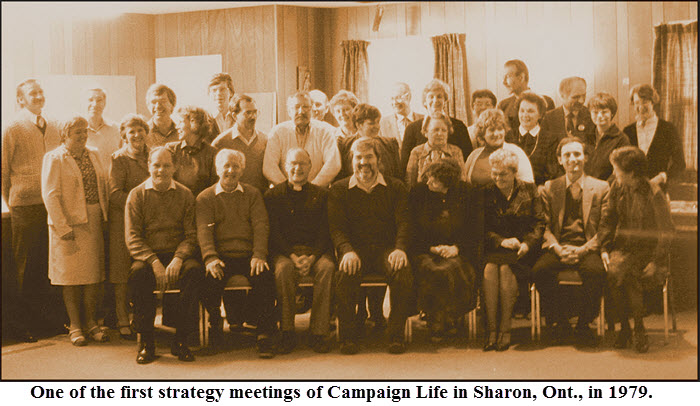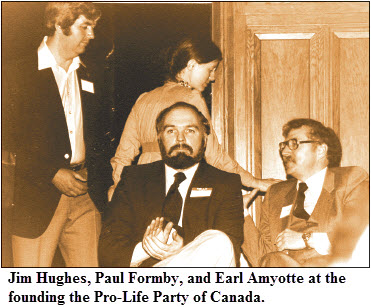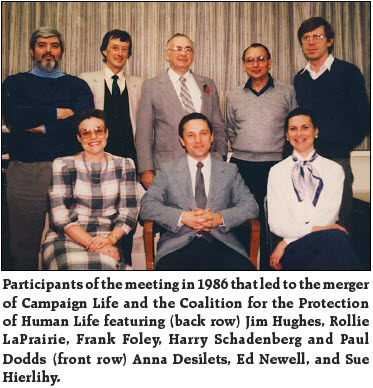CLC: 40 years of pro-life activism May 25, 2018
On May 25, 1978, a group of pro-lifers, met in Winnipeg to form a new national political pro-life organization.
With representatives from local pro-life groups in Quebec and Ontario and Western Coalition groups from Saskatchewan, Alberta and B.C., Campaign Life was formed, dedicating itself to the mission of questioning political candidates and raising public awareness on life issues throughout Canada.
Another catalyst for the new group was the realization that pro-life educational groups were being stymied in their attempts to become involved politically, risking their charitable tax status. Stephen McDonnell, president of Campaign Life Toronto, noted at the formation of the new organization: “The abortion law will only be changed when a large number of Canadians publicly demand, with unified voice, a change. The creation of Campaign Life Canada brings that day a little closer.”

Jim Hughes, who would become president of the national organization in 1984 after Alberta-based Kathleen Toth, who had served for six years, resigned the post once the Charter of Rights was passed, said that Campaign Life, and the national umbrella organization for educational groups, Alliance for Life Canada, worked together on and off for years, until the latter’s demise in the late 1990s.
He said the two groups would coordinate their efforts, with Alliance working with Right to Life groups to educate the public at the grassroots level on specific issues and Campaign Life – and later Campaign Life Coalition – working with MPs on those same issues.
Gwen Landolt, one of Campaign Life’s founders with Paul Formby and Paul Dodds, credited the Toronto priests of the Basilian order with an integral role in the startup of the new pro-life organization. “The Basilian fathers were wonderfully generous,” she said. “We used rooms and equipment at their seminary. They also freed up Paul Formby, who at that time was a seminarian, to carry on with his prolife responsibilities. Without them, there would be no Campaign Life Coalition today.”
The Basilian Formby left the Coalition to work with Campaign Life and became its national co-ordinator. He left the seminary to study law. Hughes credits fine legal minds such as Dodds, Formby, and Landolt, as well as scholars such as Professor David Dooley, Fr. Ian Boyd, Fr. Alphonse de Valk, and medical experts like Dr. John Shea as being important in adding a professionalism to the grassroots organization as they developed questionnaires, strategized about politics, wrote press releases, talked with the media, made presentations to legislatures and conferences, among other projects.
 Fr. Boyd and Formby helped create Campaign Life’s first questionnaire which asked two questions: one about whether abortion should be legal and another about abortion funding. In a trial run of two dozen by-elections in 1978, CL found the questionnaires effective in garnering information about candidates. Formby told The Interim in 2003 that they were instrumental in defeating two pro-abortion NDP candidates in a pair of Toronto ridings. CL printed tens of thousands of pamphlets and distributed them in all the Toronto
Fr. Boyd and Formby helped create Campaign Life’s first questionnaire which asked two questions: one about whether abortion should be legal and another about abortion funding. In a trial run of two dozen by-elections in 1978, CL found the questionnaires effective in garnering information about candidates. Formby told The Interim in 2003 that they were instrumental in defeating two pro-abortion NDP candidates in a pair of Toronto ridings. CL printed tens of thousands of pamphlets and distributed them in all the Toronto
ridings that held a by-election. An analysis of the results by polling stations found that where Campaign Life distributed the pamphlets, pro-life candidates received more votes than they would otherwise be expected to win.
Hughes noted that while the questionnaire has been tweaked over time, it is still an important educational
tool. He said it is important to “use objective standards to qualify candidates.” With the internet, pro-life voters come to CLC nowadays looking for that information.
While Campaign Life has been involved in every political battle affecting life issues, the three biggest are probably their fight to include protection of human life in the Charter of Rights in 1982 (or defeat it), the Mulroney abortion bills that had loopholes that would not have reduced abortion, and the stem cell research bill in the early 2000s.
CL’s Landolt prophetically warned that the Charter would be used to strike down the minor limits that existed on abortion. Formby said of the Charter battle, “we were effective in waking people up to the issues.” When the standing committee taking input from the public refused to grant Campaign Life an appointment, that didn’t deter Toth, Landolt and company, who went to Ottawa anyway and walked right into the hearings. “We made our presentation and were very well received, but we weren’t able to get the unborn into the Charter,” Toth recalled.
Of course, CLC’s main influence for the last 40 years has been in electing pro-life candidates, starting with local nominations and culminating in influencing Federal and provincial leadership contests. From Tom Wappel’s Liberal leadership race in the 90’s to Tanya Granic Allen’s Provincial Conservative race in 2018, and everything in between, Campaign Life Coalition continues to mobilize the pro-life and pro-family grassroots to get involved in politics like no other. With tens of thousands of memberships sold to various political parties, and thousands of volunteers recruited, CLC supporters continue to change election outcomes every time.
Jim Hughes joined Campaign Life Toronto in 1978, thinking it would be a two-year commitment before he
returned to his career in sales. But 40 years later, and nearly 35 years as National President, he is still working full-time applying his business skills to the pro-life movement. He calls himself a “connector” because he links people with solutions to problems that need to be solved. He has found people to take on projects that Campaign Life and CLC have initiated or brought to Canada, including organizing the National March for Life in Ottawa following in the footsteps of the late Miss Nellie Gray and the March for
Life in Washington. “There are more projects and organizations than we can remember, but when there was a need, we found a way to address it,” said Hughes.

By 1986, the few people who remained with the Coalition for Life agreed with Campaign Life on political strategy, and those who favoured compromise had left the movement. A meeting organized by Alliance for Life president Ed Newell included Hughes, Anna Desilets, Sue Heirlihy, Rollie LaPrairie, Harry Schadenberg, Paul Dodds, and Frank Foley resulted in the Coalition and Campaign joining forces under one, new banner: Campaign Life Coalition. The two groups merged in 1987. Hughes wanted someone from the Coalition side to take the presidency, but they convinced him to stay on as leader.
Hughes said that Campaign Life had a mailing list of 200 names in 1978 but that after the Charter battles, during which ads appeared in the Catholic Register, Toronto Star, and other publications, it had grown to more than 8000. Today, the mailing list has more than 175,000 names on it.
Asked what Campaign Life, and Campaign Life Coalition’s greatest success is, Hughes said that ultimately success will be defined by God, but that “in human terms, the fact we are here today,” can be counted as a victory. “We continue to grow, and we are finding more young people willing to take up the pro-life mantle. We adopted Nellie Gray’s slogan, ‘No Compromises, No Exceptions’ and added our own ‘No apologies, No excuses’.” He said CLC is laying down the tracks on which future pro-lifers will work to return legal protection for unborn life. “We are putting everything in God’s hands and trust that it will
work out in the end.”
Following is a brief video celebrating CLC's 40 year anniversary and highlighting just some of the staggering number of battles fought, and indispensible projects initiatied by CLC during this time:
